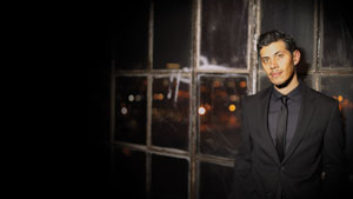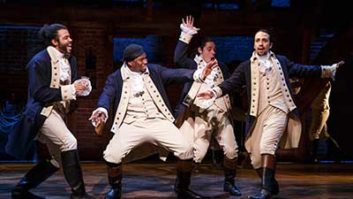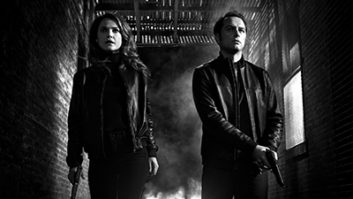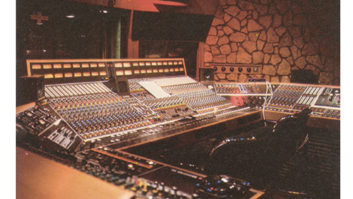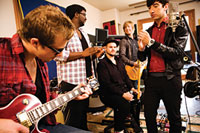
L-R: Tim Lopez, De’Mar Hamilton, Mike Retondo, Dave Tirio and Tom Higgenson
Photo: Johnny Buzzerio
Following up a hit record puts pressure on even the most established artists, but when that hit record is a band’s first major-label release and they’ve charted a Number One single in 10 countries, the pressure is seriously on — particularly if the bandmembers feel like they’ve got something to prove.
The Plain White T’s breakthrough release, Every Second Counts (Hollywood Records), sold more than a million-and-a-half copies worldwide and earned two Grammy™ nominations. This Chicago-based group — vocalist Tom Higgenson, guitarists Dave Tirio and Tim Lopez, drummer De’Mar Hamilton and bassist Mike Retondo — went into their follow-up, Big Bad World, determined to surpass what Every Second Counts had accomplished and to break free of being “The ‘Hey There Delilah’ Band.”
Clocking in at just under 35 minutes, Big Bad World doesn’t contain “Delilah, Part 2,” and that was important to the band. “It was such a huge song that it overshadowed who we really are,” says Higgenson. “A lot of people know us only by that one song. It’s up to us now to make them want to know our entire catalog.” A prolific writer with a flair for melodies, he found himself crafting much of Big Bad World on the road — in airplanes, on buses and in hotels, a far cry from the days of an indie band with no deadlines. The result is pure pop-flavored rock music, with clever lyrics, unique twists and multipart harmonies somewhat reminiscent of Higgenson’s favorites: The Beatles. “We’re trying to bring that back — the real songs, the classic kind of feel,” he says. “We want to create songs that speak to more than 2008.”
To make the album, the band again worked with Every Second Counts producer Johnny K. With his help, they pared down the 30 songs they had written and headed out on a cross-country trip. First, they rented a house in Malibu, Calif., to use for tracking. With a truck and trailer, the equipment made the trek from Chicago to Malibu. “We loaded a 20-channel Neve Melbourne with 33114A modules,” says Johnny K. “I have a couple of those consoles, so I do rent that equipment; it is part of the studio. I had a couple of my studio guys pack and drive to California while I was finishing a Staind record in Massachusetts with my other Neve Melbourne.
“I brought a pair of Genelec 1032 main monitors, used KRK powered V6s and tracked on those,” he explains. “I was really impressed; it was the first time I tracked a record with those speakers, and they’re inexpensive and did a nice job. They brought the monitors and KRKs, a folding banquet table with a blanket on it, I put the speakers on Auralex foam decouplers and we got a great sound. There was no subwoofer or anything. Most of the record was tracked on those speakers, and Andy [Wallace, mix engineer] said there was minimum EQ. I had a rack of API modules, a couple of old Neotek Series II modules, LA-2As, an 1176 vintage, a couple of Distressors, and that was it. And a slew of mics: a vintage C-24, Blue Bottles on overhead, Blue Kiwis for room mics, standard drum stuff, and for vocals a Neumann M 149.
“We approached this record differently,” Johnny K says of the production. “The last one, I set the band up in the recording studio, isolated everything, overdubbed — a standard procedure. With this record, they were all in one room with the P.A. and monitors, monitor wedges, no headphones. You hear everything all together. Tim, Mike and Tom sing harmony, and they all had mics with monitors. We wanted the warmth and ambience, and we recorded the whole album that way.
“Pre-production, rehearsals and most of the recording were done in the house we rented in Malibu,” Johnny K continues. “We recorded in May and June, and I got back to Chicago on June 20. I opened a ‘B’ room in my new building with a Neve 8128, and the first session I did here was Plain White T’s on June 20. The Neve came from Sound Emporium in Nashville. We put a remote patchbay near the producer’s desk where it originally was, reconfigured it and finished the album. We did all the strings, vocal overdubs, horns and percussion here. We tracked an entire song, ‘1234,’ in Chicago, and it came out great.
“Even though we recorded to Pro Tools HD, I approached it like an old recording. I didn’t layer the guitars; I let the ambience of the room fill out the recording rather than layers of performance. One of the philosophies we had going into it, Tom wanted to hear the parts. Layering misses the nuance of the performance. Using bleed and ambience, the performances are very individual — not layered, not doubled.”
“Johnny definitely added certain things,” Higgenson adds. “He came through with ideas. For example, in ‘Meet Me in California,’ toward the end there’s a nice break line where the chorus is just guitar parts, this really pretty thing that wasn’t in the song before. We had modulated the chorus and Johnny came up with letting the guitars shine. Several ideas on the album are his, and he gave the songs magic moments. He put a lot of himself into this album; that’s what a producer’s job is, and he nailed it.”
Johnny K produced and mixed Every Second Counts but brought in longtime colleague Andy Wallace to mix Big Bad World. “Andy’s instinct for the music is so right on the money right off the bat,” Johnny K notes. “If there are any tweaks or changes, we have a very good connection, so it seems pretty easy — the best working relationship I’ve had with any mixer as far as getting what I want. Before I became a producer, what I thought were good-sounding records, he had mixed them.
“I trust his judgment,” he continues. “I sent extra tracks and deferred to his opinion as to whether they should be included or excluded — for instance, a piano part and where it should come in. The band and I have faith in Andy. He made the call on some things, and ultimately, if a change was made, everybody agreed it was a smart change. He has great intuition and is a legendary mixer — one of the best ever.”
Wallace acknowledges similarities in the way he and the producer work, and in how they developed their expertise: “Johnny comes from the same recording and production style I’ve done,” he says. “I built my own studio. I was self-taught, if you will, and cut my teeth by doing tons of sessions. That’s what he did, producing local bands for peanuts, and that’s how he learned. We have similar miking techniques, similar philosophies on how to record basic tracks, and similar experiences on how to record live tracks.
“A lot of producers record drum machines, or if it’s live they quantize the live drums,” Wallace continues. “There’s an art to recording live drums so they don’t sound like a prerecorded sample. His raw tracks remind me of the way I record tracks, and it’s nice that there’s a more natural thing to work with and I don’t spend time working on something I don’t like or have trouble separating sound between mics. Because our general style and approach to recording and producing is compatible, and his is similar to mine, it makes it nice to work on; it’s like mixing my own tracks.”
With the band in Chicago at Johnny K’s studio and Wallace at Soundtrack in New York City, tracks were uploaded and mixes came back in “real time” via iTunes, iChat and videoconference — a first for Johnny K. “I hook Pro Tools up to my computer, we get videoconferencing, he’s at the board, I push Play, the mix comes up and I hear it immediately,” he explains. “It’s pretty exciting. The videoconference is running on my laptop and a live broadcast is coming out of the SSL in New York City directly into the outputs of the console in Chicago. He can hit the guitar track in his New York console and I hear it on mine in Chicago. If there are any changes, I talk to him on videoconference.
“I felt like I was there. I’m looking at him and talking to him, we both have Genelec speakers going, and the band at one point was still in the studio and we were all listening to the mix. In theory, basically you can get an iTunes radio thing, get a secure password and you have your own thing rolling. It goes through iTunes, but it’s a broadcast. It’s pretty cool.”
“Generally, things come in Pro Tools and I mix on an SSL J console here in Studio G at Soundtrack,” Wallace says. “I have various outboard gear, not tons — probably far less than a lot of mixers do. I mix into Pro Tools and Masterlink, and use Pro Tools as a recording medium and do some editing and effects in it.
“This CD has a live band feel,” Wallace continues. “You’re not just hearing leakage between mics. You can tell things were played together, there’s definitely a ‘real band’ live performance feel; it’s not overly arranged. I get tracks sometimes with way too much on them from an arrangement point of view. The Plain White T’s album was very well-arranged and there’s not a lot of stuff on it. What’s on there was intended to be there, and it all works together like a nice painting. It’s attributable to the band and their compositional abilities, and Johnny’s ability as a producer.
“The music came to me sorted out. Even the overdubs made sense. The tracks were cut anticipating what overdubs were coming. A lot of it was just dealing with the sonics, making sure the dynamics were good, making interesting architecture, combining things but making all the sounds big. It’s further engineering, but I didn’t have to rescue any bad-sounding tracks.”
Higgenson says that the band couldn’t be happier with the results, and credits Johnny K with much of the creative outcome. “Johnny came straight off of Three Doors Down into Staind into Plain White T’s,” he says. “He’s been working for the past year straight, so Malibu was pretty good for him, as well. He was right there with us. We all had a crazy year, and we all took advantage of the [Malibu] setting without losing track of the goal at hand.”
